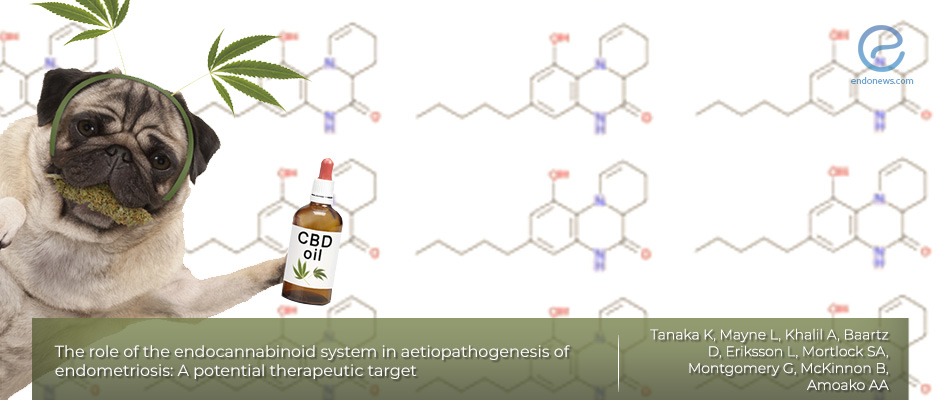Understanding endocannabinoid system in endometriosis
Mar 4, 2020
The weed in endometriosis
Key Points
Highlight:
- This is a review article summarising pieces of evidence about the roles of the endocannabinoid system in the pathogenesis of endometriosis.
Importance:
- Endocannabinoids are lipid-based neurotransmitters that bind to cannabinoid receptors expressed throughout the body. They may involve in a number of physiological processes, including fertility, pregnancy and pre- and postnatal development, though their roles are less well studied.
What's done here:
This study performed a literature search on several electronic medical databases to find original and review peer-reviewed articles that studied the endocannabinoid system in endometriosis.
Data:
- When compared to controls, differences in the level and expression of endocannabinoid system components were reported in the endometrium and circulation of women with endometriosis.
- Endometriosis was associated with the downregulation of some cannabinoid receptors and the upregulation of others, like TRPV1.
- The endocannabinoid system interacts with sex steroid hormone and has an effect on cell migration, cell proliferation, apoptosis, and inflammation, which are processes relevant to endometriosis pathogenesis.
- The possible role of cannabinoid receptors in endometriosis inflammation and pain are of interest.
Limitation:
A number of studies reported in this article are based on limited size, and there were inconsistencies among the data reported and their control groups used. Therefore, the precise role of the endocannabinoid system in endometriosis still requires large sizes and well-controlled future research.
Lay Summary
Endocannabinoids and their receptors are expressed throughout the body but have only been recently studied in depth since endocannabinoids were being discovered in 1992. In the female reproductive system, the cannabinoid receptor is expressed in the endometrium, the myometrium, the ovarian cortex, and the medulla and the uterine tubes, with functions in the menstrual cycle, ovarian maturation, embryo transplantation, and implantation. In addition, the endocannabinoid system has been shown to affect cell migration, cell proliferation, cell survival, and inflammation, which are critical processes in endometriosis development.
The article by Tanaka et al. from The Royal Brisbane and Women's Hospital and the University of Queensland, Australia hypothesized that the endocannabinoids system may influence endometriosis pathogenesis. The authors summarised previous studies which had evaluated components of the endocannabinoid system in women with endometriosis. The report was published in the European Journal of Obstetrics & Gynecology and Reproductive Biology.
The Endocannabinoids system consists of the lipid-based ligands, their receptors-cannabinoid receptors the synthetic and degradation enzymes, and protein transporters. To identify previously published articles in this area, the study performed a systematic search on electronic databases using endometriosis and endocannabinoid-related terms.
Although still controversial, a more recent study reported that cannabinoid receptor levels were lower in endometriotic tissue compared to eutopic endometrium from those without endometriosis. Interestingly, the loss of cannabinoid receptor expression was associated with inflammation, and studies suggested that progesterone promotes the anti-inflammation effect through the receptors.
Endocannabinoids synthesis and degradation enzymes were also decreased in endometriotic tissues compared to the control. In contrast, plasma levels of certain endocannabinoids were higher in patients with endometriosis compared with controls.
In terms of clinical treatment, PEA, a shorter analog of AEA has been studied in a number of endometriosis studies. When used in combination with polydatin, a compound that downregulates inflammation, PEA reduced endometriosis-related dysmenorrhoea, dyspareunia, and pelvic pain after 3 months. Another recent meta-analysis investigating the effectiveness of PEA with polydatin suggested a significant reduction in chronic pelvic pain and dysmenorrhoea.
In conclusion, there is evidence supporting the potential use of CB1 agonist in managing endometriosis-related pain. However, regarding the biology, there are still significant discrepancies in the reported concentrations and expressions of the components of the endocannabinoid system in women with endometriosis when compared to controls. Hence, future research in a large number of women with endometriosis, with pre-defined strict inclusion and exclusion criteria and clinical information will be required to inform more understanding on the exact roles of endocannabinoids system.
Research Source: https://www.ncbi.nlm.nih.gov/pubmed/31785471
treatment pain pathogenesis

